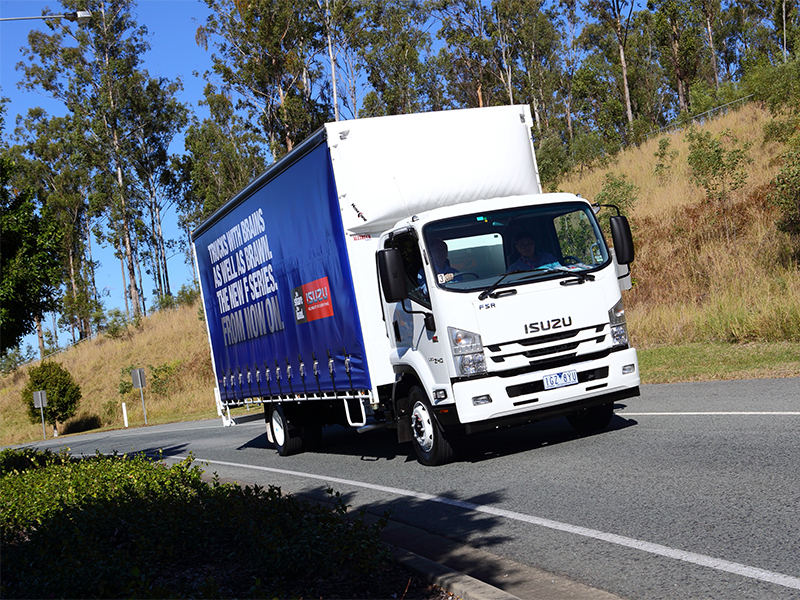A closer look at Isuzu's refurbished medium-duty F-series trucks
Never a company to rest on its laurels, Isuzu Australia’s market dominance is poised for even greater grip as its vastly refurbished medium-duty F-series trucks now hit the streets.
There’s a lot to like in the new line-up, not least a batch of gutsy new four cylinder toilers and a six cylinder range that uses a diesel oxidation catalyst (DOC) to avoid the problematic issue of particulate filter regeneration.
Yet such is the extent and standard of the new models that you’re actually left wondering if there’s any competitor even remotely capable of ending Isuzu’s dominance in the Australian truck market.
Barring unforeseen corporate catastrophe or a miraculous competitive onslaught, Isuzu will at the end of this year notch 28 consecutive years of market leadership.
It is a phenomenal achievement in such a crowded and highly competitive market.
Within Isuzu Australia, however, there is absolutely no indication of complacency or taking the competition for granted.
Market leadership will be defended and expanded at every opportunity according to senior Isuzu sources including new MD and CEO of Isuzu Australia Ltd (IAL), Hiroshi Nishizaka.
Replacing the affable Mike Yoda and before him the extremely erudite Yuki Murata, Nishizaka-san comes with an engineering background and critically, total awareness of Isuzu Australia’s prized position within the corporate cloister.
Meanwhile, in a prelude to a new F-series drive program in Brisbane recently, Isuzu Australia national sales manager Andrew Harbison highlighted a long overdue report by the Australian Bureau of Statistics (ABS) on Australian freight movements which shows not only the enormity of the domestic freight task in this country but also the critical part played by Japanese trucks in moving that freight.
The ABS report shows a whopping 95 per cent of Australia’s road freight movements occur within the same state or territory; which effectively means the metropolitan and regional distribution roles where light and medium-duty trucks of Japanese origin are the prominent providers.
Isuzu Australia has “kept a close watch on these and other findings over the years and they certainly help inform our engineering direction and overall sales approach,” Harbison said.
Consequently, every one of the nine trucks in Isuzu’s drive program stirred through either an Allison automatic or Isuzu’s latest AMT-TC (torque converter) automated transmission.
The six-speed AMT-TC is available behind the all-new 4HK1 four cylinder engine, described by Isuzu as ‘the star’ of its new medium-duty range, while an Allison auto is used behind six cylinder models.
In both four and six cylinder models though, a six-speed manual transmission is also available.
 |
|
Isuzu FSR, one of a brace of F-series trucks now powered by the new and surprisingly tenacious 4HK1 four cylinder engine.
|
The six cylinder engine is the 7.8 litre 6HK1 which comes in two ratings;
- 191 kW (256 hp) at 2400 rpm with 761 Nm (561 lb ft) of torque from 1450 to 2400 rpm.
- 221 kW (296 hp) at 2400 rpm with 981 Nm (724 lb ft) of torque at 1450rpm.
For emissions compliance, the 6HK1 runs an EGR system fitted with a diesel oxidation catalyst (DOC) and according to Isuzu it is “the only medium-duty engine in the Australian market with neither a diesel particulate filter nor SCR”.
Yet while the new four cylinder 4HK1 engine does use an EGR emissions system with a diesel particulate diffuser (filter), Isuzu is entirely confident of the engine’s environmental and efficiency credentials, and critically, its ability to avoid regeneration problems.
As a company statement explains, the 4HK1 employs Isuzu’s “latest diesel particulate diffuser system with a dedicated fuel injector in the manifold to take care of regenerations”.
There is, however, far more to the new engine than an enhanced emissions system which meets the Japanese equivalent of Euro 6.
As IAL chief engineer Simon Humphries enthused, “There’s nothing like the 4HK1 on the medium-duty truck market today and it really marks the advent of a new generation of power plant.
“There’s clear evidence of a global trend towards lower displacement engines across the automotive world as people gravitate towards lighter, more profitable and more efficient engine technology.”
Powering five models in the F-series range, the four cylinder engine displaces 5.2 litres and uses two-stage turbocharging and an intercooler to produce two performance ratings;
- 154 kW (207 hp) at 2400 rpm accompanied by 726 Nm (535 lb ft) of torque at 1600 rpm.
- 177 kW (237 hp) at 2400 rpm with 765 Nm (564 lb ft) of torque at 1600 rpm.
An adamant Phil Taylor, Isuzu Australia chief operating officer, says there are now around 180 specification variations across the brand’s entire light and medium-duty offerings, including the most comprehensive line-up of automated and automatic transmission options in the market.
Furthermore, in its ongoing bid to ensure market leadership, Isuzu at the end of August this year will also release an upgraded range of light-duty N-series trucks.


